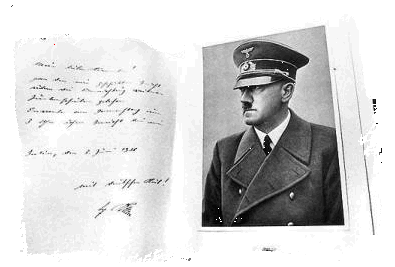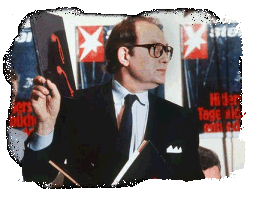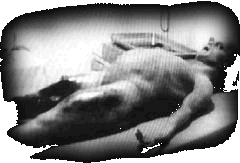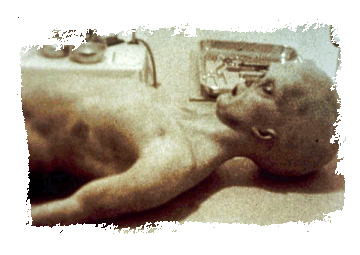It looks like you're using an Ad Blocker.
Please white-list or disable AboveTopSecret.com in your ad-blocking tool.
Thank you.
Some features of ATS will be disabled while you continue to use an ad-blocker.
5
share:
People get conned, hoaxed or made to look fools all the time. But every now and again a really big hoax hits the mainstream media. Sometimes
literally..
Here are two global “hoaxes” that have their origins based in stories from the 1940s . Both resurfaced decades later in the 1980s and 1990s respectively. One story was spotted for what it was within weeks of hitting the news and the men behind it went to prison. The other lingered for another decade and the man behind it all made a lot of money.
 In April 1983, German weekly Der Stern came out with an exclusive report on what
was seemingly the most exciting find from World War II ,the collected thoughts of Adolf Hitler in his own words, and more importantly his own
handwriting.
In April 1983, German weekly Der Stern came out with an exclusive report on what
was seemingly the most exciting find from World War II ,the collected thoughts of Adolf Hitler in his own words, and more importantly his own
handwriting.
The story began in the autumn of 1979 when an investigative reporter for the German magazine Der Stern, Gerd Heidemann, was invited to the house of a man named Fritz Stiefel, to look over some Nazi memorabilia. After going through various items, Heidemann was shocked to discover that Stiefel was in possession of a secret diary , just one of a number of volumes, that Adolf Hitler had kept. He realised this would be a journalistic scoop of the century if he could get his hands on the diaries but would need the financial might of his magazine to acquire them.
 Heidemann (pictured right) knew this meant proving the diaries were real.
Heidemann (pictured right) knew this meant proving the diaries were real.
He established that the diary in Stiefel’s possession had originally been cargo on a Junkers 352 transport that went down carrying some of Hitler's personal effects in the village of Boernersdorf at the end of the war . A chest containing some of the Fuerher’s personal effects and papers were on the aircraft. Local farmers had hidden the documents and then given them to a high ranking German officer after the war. Heidemann also learned there were even more volumes of Hitler’s diaries in the hands of a certain Konrad Fischer.
He eventually convinced Stern to purchase the diaries but found it difficult to contact Fischer. Even after contact was made, Fischer was reluctant to deal with Heidemann. Having eventually been persuaded that his anonymity would be guaranteed and a rather tempting payment of around 2m Deutschmarks offered , a deal was struck.
The first diary was delivered to Stern editorial offices in January of 1981. After that they kept appearing like diarrhoea with eventually 62 volumes spanning the period 1932-1945 turning up.
The diaries themselves portrayed Hitler as a much more genial man than in history books. He seemed to have little knowledge of his own death camps and sought to deport the Jews to other lands in the East rather than exterminate them.
It was believed that an East German General was having them smuggled out of the East in pianos. Stern paid 9.9m Deutchsmark in total. The magazine was initially sceptical but as the years went by Heidemann’s bosses became more and more convinced by his research.
Stern was also seeking to sell the publishing rights on to international media corporations.
Before bidding on the diaries, handwriting experts Max Frei-Sultzer, Ordway Hilton and Kenneth Rendell, were brought in to verify the authenticity of Hitler’s handwriting. All agreed that the diaries were authentic .The Times (UK) and Newsweek engaged historians Hugh Trevor-Roper and Gerhard Weinberg to examine the papers, with Trevor-Roper also convinced of their authenticity stating in the Times of April 24th 1983.
 Hugh Trevor-Roper & Gerhard Weinberg
Hugh Trevor-Roper & Gerhard Weinberg

It was only later discovered that the samples of Hitler’s writing provided by the West Germany Federal Archives were actually forgeries!
Of course there were doubters as soon the story broke. Long time scholar of Hitler’s life, David Irving, was the most outspoken critic of the Hitler Diaries. He had written a book “Hitler’s War” and accumulated many original letters and documents from Nazi Germany that gave him reason to testify that the Hitler Diaries were completely false. On the other hand many argued that no one could possibly forge over 60 diaries.
Upon review by the West Germany Federal Archives, they deemed that a large number of the entries were taken from “Hitler’s Speeches and Proclamations” a book by Max Domarus, a federal archivist. Errors from this document were repeated in the diaries. They were then chemically tested. Experts analyzed the ink and found that it was less than a year old. The paper was placed under an ultraviolet light and contained a paper whitening chemical that was not used in paper manufacturing until 1954. The glue and bindings were also created after World War II. When another sample of Hitler’s writing was compared to the questioned documents, it was found that the handwriting did not match.
The consequences were that Trevor-Roper's reputation was ruined and editors at Stern, the Sunday Times and Newsweek lost their jobs . As for the diaries themselves, they turned out to be the work of notorious Stuttgart forger Konrad Kujau. Both Heidemann and Kujau went to trial and were each sentenced to 42 months in prison for forgery and embezzlement.
 Some 30 years later, in April 2013, fake history took it’s place in real history
. Germany's Federal Archives accepted a collection of the forgeries from Stern, not as part of Nazi history, but as a part of news media history.
Some 30 years later, in April 2013, fake history took it’s place in real history
. Germany's Federal Archives accepted a collection of the forgeries from Stern, not as part of Nazi history, but as a part of news media history.
Konrad Kujau – Forging ahead
And so we move on…………(continues below)
Here are two global “hoaxes” that have their origins based in stories from the 1940s . Both resurfaced decades later in the 1980s and 1990s respectively. One story was spotted for what it was within weeks of hitting the news and the men behind it went to prison. The other lingered for another decade and the man behind it all made a lot of money.
The Hitler Diaries
 In April 1983, German weekly Der Stern came out with an exclusive report on what
was seemingly the most exciting find from World War II ,the collected thoughts of Adolf Hitler in his own words, and more importantly his own
handwriting.
In April 1983, German weekly Der Stern came out with an exclusive report on what
was seemingly the most exciting find from World War II ,the collected thoughts of Adolf Hitler in his own words, and more importantly his own
handwriting. The story began in the autumn of 1979 when an investigative reporter for the German magazine Der Stern, Gerd Heidemann, was invited to the house of a man named Fritz Stiefel, to look over some Nazi memorabilia. After going through various items, Heidemann was shocked to discover that Stiefel was in possession of a secret diary , just one of a number of volumes, that Adolf Hitler had kept. He realised this would be a journalistic scoop of the century if he could get his hands on the diaries but would need the financial might of his magazine to acquire them.
 Heidemann (pictured right) knew this meant proving the diaries were real.
Heidemann (pictured right) knew this meant proving the diaries were real. He established that the diary in Stiefel’s possession had originally been cargo on a Junkers 352 transport that went down carrying some of Hitler's personal effects in the village of Boernersdorf at the end of the war . A chest containing some of the Fuerher’s personal effects and papers were on the aircraft. Local farmers had hidden the documents and then given them to a high ranking German officer after the war. Heidemann also learned there were even more volumes of Hitler’s diaries in the hands of a certain Konrad Fischer.
He eventually convinced Stern to purchase the diaries but found it difficult to contact Fischer. Even after contact was made, Fischer was reluctant to deal with Heidemann. Having eventually been persuaded that his anonymity would be guaranteed and a rather tempting payment of around 2m Deutschmarks offered , a deal was struck.
The first diary was delivered to Stern editorial offices in January of 1981. After that they kept appearing like diarrhoea with eventually 62 volumes spanning the period 1932-1945 turning up.
The diaries themselves portrayed Hitler as a much more genial man than in history books. He seemed to have little knowledge of his own death camps and sought to deport the Jews to other lands in the East rather than exterminate them.
It was believed that an East German General was having them smuggled out of the East in pianos. Stern paid 9.9m Deutchsmark in total. The magazine was initially sceptical but as the years went by Heidemann’s bosses became more and more convinced by his research.
Stern was also seeking to sell the publishing rights on to international media corporations.
Before bidding on the diaries, handwriting experts Max Frei-Sultzer, Ordway Hilton and Kenneth Rendell, were brought in to verify the authenticity of Hitler’s handwriting. All agreed that the diaries were authentic .The Times (UK) and Newsweek engaged historians Hugh Trevor-Roper and Gerhard Weinberg to examine the papers, with Trevor-Roper also convinced of their authenticity stating in the Times of April 24th 1983.
I am now satisfied that the documents are authentic; that the history of their wanderings since 1945 is true; and that the standard accounts of Hitler's writing habits, of his personality and, even, perhaps, of some public events, may in consequence have to be revised.


It was only later discovered that the samples of Hitler’s writing provided by the West Germany Federal Archives were actually forgeries!
Of course there were doubters as soon the story broke. Long time scholar of Hitler’s life, David Irving, was the most outspoken critic of the Hitler Diaries. He had written a book “Hitler’s War” and accumulated many original letters and documents from Nazi Germany that gave him reason to testify that the Hitler Diaries were completely false. On the other hand many argued that no one could possibly forge over 60 diaries.
Upon review by the West Germany Federal Archives, they deemed that a large number of the entries were taken from “Hitler’s Speeches and Proclamations” a book by Max Domarus, a federal archivist. Errors from this document were repeated in the diaries. They were then chemically tested. Experts analyzed the ink and found that it was less than a year old. The paper was placed under an ultraviolet light and contained a paper whitening chemical that was not used in paper manufacturing until 1954. The glue and bindings were also created after World War II. When another sample of Hitler’s writing was compared to the questioned documents, it was found that the handwriting did not match.
The consequences were that Trevor-Roper's reputation was ruined and editors at Stern, the Sunday Times and Newsweek lost their jobs . As for the diaries themselves, they turned out to be the work of notorious Stuttgart forger Konrad Kujau. Both Heidemann and Kujau went to trial and were each sentenced to 42 months in prison for forgery and embezzlement.
 Some 30 years later, in April 2013, fake history took it’s place in real history
. Germany's Federal Archives accepted a collection of the forgeries from Stern, not as part of Nazi history, but as a part of news media history.
Some 30 years later, in April 2013, fake history took it’s place in real history
. Germany's Federal Archives accepted a collection of the forgeries from Stern, not as part of Nazi history, but as a part of news media history.Konrad Kujau – Forging ahead
And so we move on…………(continues below)
edit on 11/5/13 by mirageman because: typos
Alien Autopsy: Fact or Fiction

Back in the 1992, Ray Santili, a British Entrepreneur, had been searching for rare footage of Elvis Presley in the United States. He claimed that after visiting a former cameraman from the US military, he had acquired around 90 min. of film of the original autopsy of a captured alien from 1947.
The back story to all of this was that sometime in the summer of 1947 , the unnamed “cameraman” was told to prepare for a special assignment as part of a team who would film the recovery of a Russian “spy plane”. The team later flew to Roswell and were then driven by truck to a crash site in New Mexico. The area was cordoned off by the military on their arrival.
There were injured creatures lying on the ground and debris from somekind of craft. The creatures were transported to a makeshift clinic on the base at Ft. Worth and the craft and debris were sent to Wright-Patterson. Two to three weeks later the cameraman was asked to film three “autopsies”. Somewhere along the way, the cameraman was never asked to release a number of reels still in his possession and so he stored them for forty-five years until Ray Santili turned up. He sold twenty-three film reels to Ray for $100,000! The "Santili Footage" consists of four different films that included the crash debris, footage shot in a tent and the dissections and autopsies of the strange entities.
“… I have the advantage of dealing with the cameraman first hand. I’m not dealing with second hand information, it’s a person I’ve known on and off for two years, I’ve had various meetings with him, we’ve managed to go through his diaries, his records, his photo album. We’ve seen his collection of old cameras, and you know, we’ve heard all the stories. The guy is genuine, I know he’s genuine, I believe that the footage is genuine, but in time only people that can do more research will be able to judge it more critically.”
(Ray Santilli interview with Philip Mantle; June 25th 1995.)
In May 1995 both Santilli and Gary Shoefield a business partner, previewed some of the footage to selected media, press and ufologists. Three months later in late August 1995, a video aired on Channel 4 in the UK and the Fox network in the USA called “Alien Autopsy: Fact or Fiction”. Presented by Jonathan Frakes, of Star Trek the Next Generation fame.
 By the end of the summer the film had been shown in over 30 countries on TV and
was being hotly debated. The TV special, adapted for each territory, managed to pull in around a billion viewers worldwide.
By the end of the summer the film had been shown in over 30 countries on TV and
was being hotly debated. The TV special, adapted for each territory, managed to pull in around a billion viewers worldwide. Although it had been considered fake as soon as snippets first appeared on TV, a number of people still believed that the Santili footage may contain something genuinely otherworldly on into the 21st century. One of those was the recently departed Reg Presley , former lead singer of the Troggs. Presley was convinced by Santili’s story who had had always maintained a stance of “if you think it’s fake, prove it” over the footage.

The whole story was eventually adapted for a comedy film “Alien Autopsy” in 2006 starring British TV presenters Ant & Dec (Anthony McPartlin & Declan Donnelly) in the lead roles . Despite conceding that the actual footage shown on TV was faked up, and the film told the story of the whole saga, Santili was adamant that some footage did survive and was placed in the film without ever indicating exactly which parts. The obvious place is a sequence at the end of the film
Does it still convince anyone though today?
An investigation by Phil Mantle later led him to believe the whole tale was a massive hoax.

Gary Shoefield and Ray Santili in 2006
Whereas Heidemann, went to jail for creating fake history with the Hitler Diaries stories and was ruined by the whole affair, Santili remained a free man and milked every last drop from his Alien Autopsy episode for over a decade.
Was there a difference in what both men did for huge sums of money from the media?
The Hitler diary affair embarrassed media executives and cost their newspapers a lot of money, time and respect.
The Alien Autopsy case appears to have been treated as little more than an entertainment story by the media. Santili played the whole thing very cleverly with a topic that he knew most serious journalists would never touch. Faking (what many believe is) fake history is a little different from faking real history. Such a fine line between a hoax and a crime.
There are many more hoaxes throughout history that I may pick up on again at a later date.
Thanks for reading.
edit on 11/5/13 by mirageman because: tidy up
I think the hitler diaries back then would be harder to prove fake but as time went on & technology got better they were found to be fakes,if they
came out today they would be found as fakes alot quicker & not as money would have been made & changed hands.
alien autopsy i've never really been sure about,85% fake 15% i'm not sure..always interesting read though.
alien autopsy i've never really been sure about,85% fake 15% i'm not sure..always interesting read though.
reply to post by rhynouk
I do remember the Hitler Diaries story when I was still at school and the general feeling was that the story was a hoax even back in the days before the internet, and global news 24 hours a day.
I am certain that today there would be absolutely no chance of the Hitler Diaries surfacing as technology is so much more advanced today. Of course the technology we have now also presents a problem for future historians as they try to establish whether electronic documents are genuine or not.
As for the Alien Autopsy then judge for yourself:
There was also this
And then this
There may well be footage of something from New Mexico in 1947 that still exists. But I doubt Ray Santili ever had his hands on it.
I do remember the Hitler Diaries story when I was still at school and the general feeling was that the story was a hoax even back in the days before the internet, and global news 24 hours a day.
I am certain that today there would be absolutely no chance of the Hitler Diaries surfacing as technology is so much more advanced today. Of course the technology we have now also presents a problem for future historians as they try to establish whether electronic documents are genuine or not.
As for the Alien Autopsy then judge for yourself:
There was also this
And then this
There may well be footage of something from New Mexico in 1947 that still exists. But I doubt Ray Santili ever had his hands on it.
edit on 11/5/13 by mirageman because: link fixed
new topics
-
Paradox of Progress
Ancient & Lost Civilizations: 4 hours ago -
Joe Biden gives the USA's Highest Civilian Honor Award to Hillary Clinton and George Soros.
US Political Madness: 6 hours ago -
Winter Storm
Fragile Earth: 7 hours ago -
Biden Face Planted Somewhere
Politicians & People: 9 hours ago -
A great artist and storyteller, for kids of all ages
General Entertainment: 10 hours ago
top topics
-
Joe Biden gives the USA's Highest Civilian Honor Award to Hillary Clinton and George Soros.
US Political Madness: 6 hours ago, 13 flags -
What Is 'Quad Demic'? Mask Mandate Returns In These US States
Diseases and Pandemics: 13 hours ago, 11 flags -
Volcano Watch 2025
Fragile Earth: 15 hours ago, 8 flags -
The Future of fashion .
Social Issues and Civil Unrest: 14 hours ago, 8 flags -
Winter Storm
Fragile Earth: 7 hours ago, 7 flags -
Bin Cyber Junk…
Short Stories: 14 hours ago, 6 flags -
Biden Face Planted Somewhere
Politicians & People: 9 hours ago, 5 flags -
A great artist and storyteller, for kids of all ages
General Entertainment: 10 hours ago, 5 flags -
Paradox of Progress
Ancient & Lost Civilizations: 4 hours ago, 5 flags -
The Undertones - Teenage Kicks
Music: 15 hours ago, 3 flags
5
